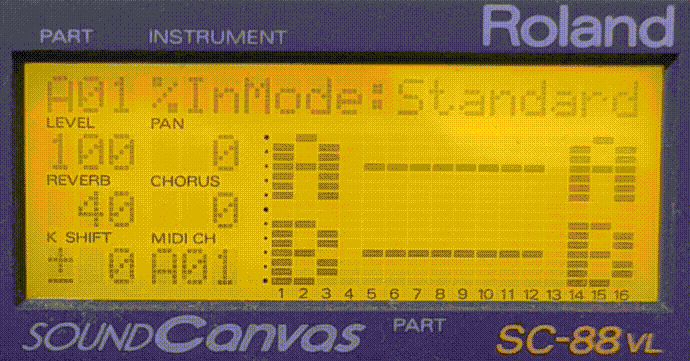Roland SC-88
- Not to be confused with the Roland SC-88 Pro.
| W × H × D (mm) | 218 × 72 × 250[1] |
|---|---|
| Rack units | ~1.6U, half-width |
| Type | GM/GS sound module |
| Manufacturer | Roland |
| Release date | 1994 |
| Standards | Roland GS[1] General MIDI[1] |
| Parts | 32[1] |
| Max polyphony | 64[1] |
| Normal presets | 654[1] |
| Drum presets | 24[1] |
| Effects | Reverb, Chorus, Delay, 2-band EQ[1] |
| ← Roland SC-55 | |
| Roland SC-88 Pro → | |
The Roland SC-88 is a Roland GS and General MIDI sound module in the Sound Canvas series, introduced by Roland in 1994. It introduced several major upgrades over the SC-55:
- Maximum polyphony more than doubled from 24/28 to 64 voices
- Number of parts doubled from 16 to 32 (two MIDI inputs)
- A separate delay effect unit was added (independent from the reverb unit, which already could do delay effects), allowing use of delay simultaneously to reverb and chorus
- A two-band equalizer effect was added
- Many new sounds and drumkits were added, including new versions of capital (GM) tones
- A mostly-accurate copy of the SC-55 sounds was included, and it is possible to switch back and forth between SC-55 and SC-88 maps on a per-part basis
It also marked a change in form factor, with the unit height increasing to accommodate additional controls and ports.
A major upgrade to the SC-88, the Roland SC-88 Pro, was released in 1996.
Quirks
Multi-port MIDI data
The SC-88 has 32 parts accessible from two MIDI input ports, which introduces new compatibility issues not present on the SC-55, which only had 16 parts:
- Some MIDI files don't contain the correct information telling the MIDI player which tracks should be sent to which port. This can cause the tracks to be sent to the wrong port, which may sound wrong.
- It usually does not matter which output from your MIDI player is connected to which input port on the SC-88. However, there is a SysEx message, "CHANNEL MSG RX PORT", that tells the SC-88 to receive MIDI data for a part from a specific port. Unlike other SysEx messages, the port in this message does not get automatically swapped if it is sent to a different port than intended. Therefore, MIDI files which use this message can sound wrong if the first MIDI output in your MIDI player is connected to port B of the SC-88 rather than port A (perhaps vice-versa in rare cases). The SC-88 has an "In Mode" setting that allows swapping ports A and B,[2] which means this can be fixed without needing to physically swap cables:
